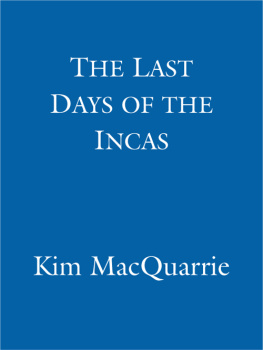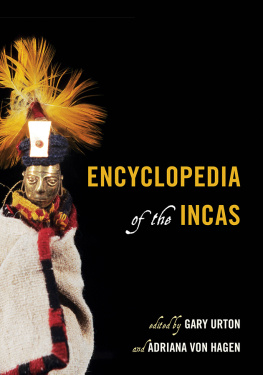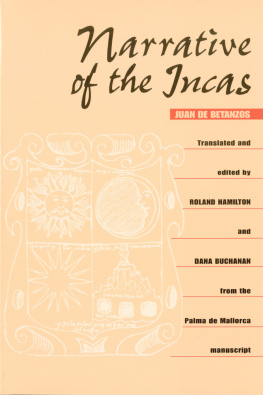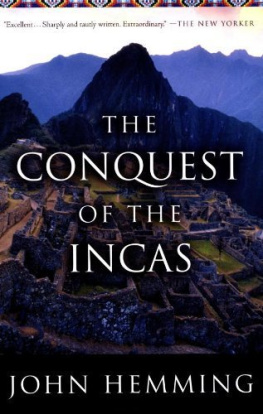Kim MacQuarrie - The Last Days of the Incas
Here you can read online Kim MacQuarrie - The Last Days of the Incas full text of the book (entire story) in english for free. Download pdf and epub, get meaning, cover and reviews about this ebook. publisher: Little, Brown, genre: History. Description of the work, (preface) as well as reviews are available. Best literature library LitArk.com created for fans of good reading and offers a wide selection of genres:
Romance novel
Science fiction
Adventure
Detective
Science
History
Home and family
Prose
Art
Politics
Computer
Non-fiction
Religion
Business
Children
Humor
Choose a favorite category and find really read worthwhile books. Enjoy immersion in the world of imagination, feel the emotions of the characters or learn something new for yourself, make an fascinating discovery.
- Book:The Last Days of the Incas
- Author:
- Publisher:Little, Brown
- Genre:
- Rating:4 / 5
- Favourites:Add to favourites
- Your mark:
- 80
- 1
- 2
- 3
- 4
- 5
The Last Days of the Incas: summary, description and annotation
We offer to read an annotation, description, summary or preface (depends on what the author of the book "The Last Days of the Incas" wrote himself). If you haven't found the necessary information about the book — write in the comments, we will try to find it.
The Last Days of the Incas — read online for free the complete book (whole text) full work
Below is the text of the book, divided by pages. System saving the place of the last page read, allows you to conveniently read the book "The Last Days of the Incas" online for free, without having to search again every time where you left off. Put a bookmark, and you can go to the page where you finished reading at any time.
Font size:
Interval:
Bookmark:

Kim MacQuarrie is a writer, an anthropologist, and a four-time Emmy-winning documentary filmmaker who has made films in such disparate regions as Siberia, Papua New Guinea, and Peru. MacQuarrie is the author of three previous books on Peru and lived in that country for five years, exploring many of the locations and hidden regions he chronicled in The Last Days of the Incas. During that time, MacQuarrie lived with a recently-contacted tribe of native Amazonians, called the Yora. It was MacQuarries experience filming a nearby group of indigenous people, whose ancestors still remembered their contacts with the Inca Empire, that ultimately led him to investigate and then to write The Last Days of the Incas. MacQuarrie currently divides his time between Peru, Thailand, and the U.S.
Visit the author at www.kimmacquarrie.com or you can read his blog at www.lastdaysoftheincas.com/wordpress

INEVITABLY, IN A WORK OF THIS SORT, I OWE MANY PEOPLE A great deal of thanks. Years ago, when I worked for a stint as a writer for the Lima Times, I met and interviewed the explorer and architect Vincent Lee, who with his wife, Nancy, happened to be passing through Lima after one of their many trips to Vilcabamba. I was relatively new in Peru at the time, was doing graduate work in anthropology, and had only just visited Machu Picchu. It was on a bookshelf in a small hostal far below the Inca citadel that I discovered Lees first book, Sixpac Manco. It was my initial glimpse into the world of Vilcabamba, and I was shocked to learn that people were still exploring for and discovering new Inca ruins in the area. Many years later, Vince was kind enough to supply drawings of his detailed reconstructions of Vilcabamba and some of the other nearby ruins for this book. I am proud to call Vince and Nancy friends.
My UK agent, Julian Alexander, never swerved from his initial enthusiasm when I suggested writing an account of the story of Manco Inca and Vilcabamba; it was through his indefatigable efforts and those of my US agent, Sarah Lazin, that this book became a reality. To both of them, I owe a strong debt of gratitude.
I owe many thanks to my editor at Simon & Schuster, Bob Bender, who was also enthusiastic from the very beginning and who always offered great advice and encouragement. During the years that it took to write this book, he was as solid an editor as one could hope for. Thanks also to Ariana Dingman for designing a great book cover, to Fred Chase, the meticulous copy editor, and to Johanna Li, the editorial assistant. To Alan Brooke at Piatkus Books, UK, I am also grateful for his assistance.
During the writing of the book, I relied upon a wide variety of sources and collections. I found the UCLA library system and its excellent Latin American collection to be first rate. I want to thank the staff there, the staff of the map room collection, and also the staffs at libraries in such disparate locations as London; NYC; Washington, DC; and Lima.
A number of specialists were kind enough to take the time from their busy schedules in order to read portions of this book and to offer their insightful comments. Many thanks to Vincent Lee, Dr. Terrence DAltroy, Dr. Johan Reinhard, Dr. Noble David Savage, Dr. Brian S. Bauer, Dr. Matthew Restall, Dr. Jeremy Mumford, and Dr. Kris Lane. If any errors have remained in the manuscript, I am solely to blame.
I would also like to thank Bart Lewis, who was a great help in many ways, as well as Gary Ziegler, James Gierman, Adriana von Hagen, Sean Savoy, Gene Savoy, Nick Asheshov, Paul Goldrick, Layne MacQuarrie, and Dr. Douglas Sharon, of the Phoebe A. Hearst Museum of Anthropology. Sadhbh Walshe was one of the first to read the entire manuscript at an early stage and made many helpful comments. Finally, I would like to express my love and gratitude to Ciara Byrne, who, more than anyone else, helped to make this book a reality.
Gold of the Andes: The Llamas, Alpacas, Vicuas
and Guanacos of South America
Perus Amazonian Eden: Manu National Park
and Biosphere Reserve
Where the Andes Meet the Amazon
July 24, 1911
THE GAUNT, THIRTY-FIVE-YEAR-OLD AMERICAN EXPLORER, Hiram Bingham, clambered up the steep slope of the cloud forest, on the eastern flank of the Andes, then paused beside his peasant guide before taking off his wide-brimmed fedora and wiping the sweat from his brow. Carrasco, the Peruvian army sergeant, soon climbed up the trail behind them, sweating in his dark, brass-buttoned uniform and hat, then leaned forward and placed his hands on his knees in order to catch his breath. Bingham had been told that ancient Inca ruins were located somewhere high up above them, nearly in the clouds, yet Bingham also knew that rumors about Inca ruins were as rampant in this little explored region of southeastern Peru as the flocks of small green parrots that often wheeled about, screeching through the air. The six-foot-four, 170-pound Bingham was fairly certain, however, that the lost Inca city he was searching for did not lie ahead. Bingham, in fact, had not even bothered to pack a lunch for this trek, hoping instead to make a quick journey up from the valley floor, to verify whatever scattered ruins might lie upon the jagged peak rising above, and then to hurry back down. As the lanky American with the close-cropped brown hair and the thin, almost ascetic face began to follow his guide up the trail again, he had no idea that within just a few hours he would make one of the most spectacular archaeological discoveries in history.
The air lay humid and warm upon them, and, looking up, they saw the ridgetop they were seeking stood another thousand feet above, obscured by sheer-sided slopes festooned with dripping vegetation. Above the ridge, swirling clouds alternately hid and then revealed the jungle-covered peak. Water glistened from freshly fallen rain, while an occasional mist brushed across the mens upturned faces. Alongside the steep path, orchids erupted in bright splashes of violet, yellow, and ocher. For a few moments the men watched a tiny hummingbirdno more than a shimmer of fluorescent turquoise and bluebuzz and dart about a cluster of flowers, then disappear. Only a half hour earlier, all three had carefully stepped around a vibora, a poisonous snake, its head mashed in by a rock. Had it been killed by a local peasant? Their guide had only shrugged his shoulders when asked. The snake, Bingham knew, was one of many whose bite could cripple or kill.
An assistant professor of Latin American history and geography at Yale University, Bingham ran a hand down one of the heavy cloth leg wrappings that he had wound all the way up from his booted ankles to just below his knees. Might prevent a snakebite, Bingham no doubt thought. Sergeant Carrasco, the Peruvian military man who had been assigned to the expedition, meanwhile, undid the top buttons to his uniform. The guide trudging ahead of themMelchor Arteagawas a peasant who lived in a small house on the valley floor more than a thousand feet below. It was he who told the two men that on top of a high mountain ridge Inca ruins could be found. Arteaga wore long pants and an old jacket, and had the high cheekbones, dark hair, and aquiline eyes of his ancestorsthe inhabitants of the Inca Empire. Arteagas left cheek bulged with a wad of coca leavesa mild form of cocaine narcotic that once only the Inca royalty had enjoyed. He spoke Spanish but was more at home in Quechua, the Incas ancient language. Bingham spoke heavily accented Spanish and no Quechua; Sergeant Carrasco spoke both.
Font size:
Interval:
Bookmark:
Similar books «The Last Days of the Incas»
Look at similar books to The Last Days of the Incas. We have selected literature similar in name and meaning in the hope of providing readers with more options to find new, interesting, not yet read works.
Discussion, reviews of the book The Last Days of the Incas and just readers' own opinions. Leave your comments, write what you think about the work, its meaning or the main characters. Specify what exactly you liked and what you didn't like, and why you think so.





